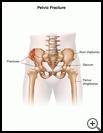
Pelvic Fracture
________________________________________________________________________
KEY POINTS
- The pelvic area is a ring or girdle of bones that includes your hipbones, the lower part of your spine, and your pubic bones. A pelvic fracture is a break or crack in any of these bones. Pelvic fractures can be minor or life threatening.
- Treatment depends on where the bones are broken, whether the bones are out of place, and whether you have other injuries.
- Ask your provider how long it will take to recover and when you can return to your normal activities.
________________________________________________________________________
What is a pelvic fracture?
The pelvic area is a ring or girdle of bones that includes your hipbones, the lower part of your spine, and your pubic bones. A pelvic fracture is a break or crack in any of these bones.
Pelvic fractures can be minor or life threatening. A serious pelvic fracture may cause damage to the pelvic organs and tissues. These structures include the bladder, bowel, uterus, urethra, blood vessels, nerves, ligaments, tendons, skin, and genitalia.
Get medical care right away for a pelvic injury to yourself or others.
What is the cause?
A pelvic fracture may be caused by a sudden forceful blow or a fall. For example, you can fracture your pelvis:
- In a car or motorcycle accident
- If you have a sports accident such as when skiing or biking
- If you fall from a high place
If you have weak or brittle bones, a fall from a standing position can cause a pelvic fracture. Osteoporosis is a thinning and weakening of the bones that can happen as you get older. Other diseases, such as cancer and kidney disease, may also weaken bones and make it easier for them to break.
What are the symptoms?
A minor pelvic fracture may cause pain but no other problems.
Signs and symptoms include:
- Pain in your lower belly, low back, upper legs, or hips
- Blood in the urine or bowel movements
- Low blood pressure and rapid heart beat
- Dizziness and pale skin color
- Swelling or bruising in the lower belly area or genitals
How is it diagnosed?
Your healthcare provider will ask about your symptoms and medical history and examine you. Tests may include X-rays or other scans.
How is it treated?
Treatment depends on:
- Where the bones are broken
- How many bones are broken
- Whether the bones are out of place
- Whether you have damage to other tissues or organs
You may need:
- Rest with gentle exercise if recommended by your healthcare provider
- Medicine for pain control and to prevent or treat infections
- External support for the pelvis, such as a walker or crutches, to keep the bones in place while they mend
- Surgery
- External orthopedic frames that hold the broken bones in place to mend
For serious fractures, you may need to stay in the hospital.
You may need physical therapy to help you gain strength and motion as you heal.
How can I take care of myself?
Follow the full course of treatment your healthcare provider prescribes.
To keep swelling down and help relieve pain:
- Put an ice pack, gel pack, or package of frozen vegetables wrapped in a cloth on the injured area every 3 to 4 hours for up to 20 minutes at a time.
- Take pain medicine as directed by your healthcare provider.
Ask your provider:
- How long it will take to recover
- If there are activities you should avoid and when you can return to your normal activities
- How to take care of yourself at home
- What symptoms or problems you should watch for and what to do if you have them
Make sure you know when you should come back for a checkup. Keep all appointments for provider visits or tests.
How can I help prevent pelvic fractures?
- Wear protective equipment during sports and when doing activities that involve heights or speed.
- Wear your seatbelt whenever you are in the car.
- If you are at risk for fractures because of osteoporosis, make your home as safe as possible to prevent falls.

